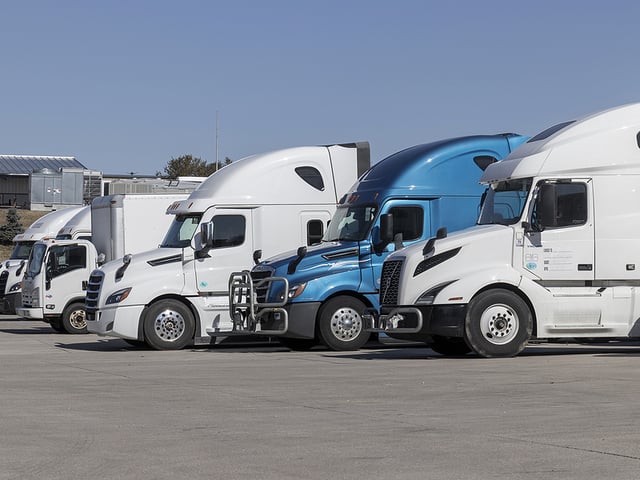
How Many Questions are on the CDL Permit Test?
Embarking on a career in commercial truck driving begins with a crucial step: passing the Commercial Driver’s License (CDL) Permit Test. This test is not just a formality; it’s a fundamental part of ensuring that every aspiring truck driver has the necessary knowledge and skills to operate large vehicles safely and efficiently on public roads. The CDL Permit Test is the gateway to a rewarding career in the trucking industry, a sector that keeps the economy moving and is essential to the distribution of goods across the nation.
In this blog, we aim to demystify the CDL Permit Test for you. How many questions can you expect on test day? What topics do these questions cover? Are there variations on the CDL test from state to state? Whether you’re just starting your journey or are close to the test date, this guide is crafted to assist you every step of the way.
What is the CDL Permit Test?
The CDL Permit Test, often referred to as the CDL General Knowledge Test, is the first significant hurdle for anyone aspiring to become a commercial driver. This test assesses your understanding of basic road safety, commercial vehicle operation, and industry-specific regulations. It’s designed to ensure that you have the foundational knowledge required to safely operate a commercial vehicle.
Passing this test grants you a Commercial Learner’s Permit (CLP), allowing you to practice driving a commercial vehicle on public roads under the supervision of a licensed CDL holder. This step is crucial not only for gaining hands-on experience but also for preparing for the CDL exam, which comprises both a written portion and a road skills test. The road skills portion of the exam is an essential assessment of your ability to handle a commercial vehicle in real-world traffic conditions and scenarios, ensuring that you can effectively apply your knowledge and skills as a commercial driver.
Nationwide Standards for the CDL Permit Test
The Commercial Driver’s License (CDL) Permit Test across the United States adheres to certain nationwide standards to ensure consistency and comprehensiveness in assessing the knowledge of aspiring commercial drivers. Understanding the general structure of the test is crucial for effective preparation.
General Structure of the CDL Permit Test
The CDL Permit Test typically comprises sections that cover a range of topics pertinent to commercial driving. These topics include general knowledge about operating large vehicles, air brakes, combination vehicles, and basic safety controls. The structure is designed to assess not only your knowledge of driving and operating a commercial vehicle but also your understanding of the regulations and responsibilities that come with a CDL. The test ensures that all commercial drivers have a consistent level of knowledge regardless of where they are in the country.
Average Number of Questions on the CDL Permit Test
Nationally, the CDL Permit Test usually consists of around 50 questions, although this number can vary slightly by state. The test is comprehensive enough to cover all necessary areas without being overly lengthy. It’s important to check with your local DMV for the exact number of questions for your specific state, as there can be slight variations.
Types of Questions on the CDL Permit Test
The questions on the CDL Permit Test are primarily formatted as multiple choice and true/false. This format is chosen for its effectiveness in assessing a candidate’s knowledge in a clear and straightforward manner. Multiple-choice questions typically present a scenario or a fact-based question with several possible answers, from which you must choose the most correct one. True/false questions, on the other hand, require you to assess the accuracy of a statement. This variety in question types ensures a comprehensive evaluation of your understanding of the material.
State-Specific Variations
Each state in the U.S. has the authority to tailor the CDL Permit Test according to its specific road laws and commercial driving regulations. These variations can be seen in aspects such as the number of questions, the passing score, and sometimes the content focus within the test. For example, states with more rural areas or specific industry demands might emphasize certain vehicle types or driving conditions. Understanding these state-specific nuances is crucial for test-takers, especially for those who may be moving between states or driving across state lines. Notable features of different states are highlighted in the chart below:
| State | Number of Questions | Passing Score | Unique Focus Areas |
|---|---|---|---|
| Alaska | 50 | 80% | cold weather operations, remote area driving |
| Arizona | 30 | 80% | desert driving conditions, heat-related vehicle care |
| California | 55 | 80% | earthquake procedures, state laws |
| Colorado | 50 | 85% | mountain driving, hazard handling |
| Florida | 50 | 80% | hurricane preparedness, wet road driving |
| Georgia | 50 | 80% | agricultural transport, rural road navigation |
| Illinois | 50 | 80% | urban and rural driving balance, Midwest weather conditions |
| Louisiana | 50 | 80% | waterway proximity transport, hot and humid climate driving |
| Maine | 40 | 85% | cold climate driving, forest product transport |
| Michigan | 50 | 80% | Great Lakes region transport, seasonal road conditions |
| Minnesota | 40 | 80% | winter driving, icy road handling |
| Nevada | 50 | 80% | desert terrain, long-distance routes |
| New York | 50 | 80% | urban driving, toll road regulations |
| North Carolina | 50 | 80% | agriculture-focused transport, hurricane season considerations |
| Ohio | 40 | 80% | industrial transport, rural and urban road balance |
| Oregon | 35 | 85% | environmental regulations, logging industry transport |
| Pennsylvania | 50 | 83% | Appalachian Mountain driving, historical area navigation |
| Texas | 60 | 80% | long-haul trucking, highway safety |
| Virginia | 50 | 86% | Atlantic coast driving, varied terrain navigation |
| Washington | 40 | 80% | ferry operations, logging roads |
Key Topics Covered in the CDL Permit Test
The CDL Permit Test, regardless of state-specific variations, consistently covers several key topics that are crucial for every commercial driver to understand. These subjects form the backbone of the test and are essential for ensuring that all CDL holders are well-prepared for the challenges of commercial driving.
The test encompasses a range of topics, each designed to assess your knowledge and readiness for a career in commercial trucking. These include:
-
Road Safety: This includes understanding traffic laws, recognizing road signs, and knowing safe driving practices. It’s about how to operate a commercial vehicle safely in various traffic and environmental conditions.
-
Vehicle Operation: This section covers the specifics of operating large commercial vehicles, such as pre-trip inspections, controlling the vehicle under various road conditions, and maneuvering techniques.
-
Basic Vehicle Maintenance: Knowledge of basic vehicle maintenance ensures that drivers can perform routine checks and identify potential issues before they lead to breakdowns or accidents.
-
Cargo Management: This involves the safe and efficient handling of cargo, including securing loads and understanding weight limits and distribution.
-
Transportation of Hazardous Materials: For those who will be transporting hazardous materials, understanding the specific regulations and safety procedures is crucial.
-
Air Brakes: If the vehicle is equipped with air brakes, understanding how they work and how to maintain them is essential.
-
Emergency Responses: This includes knowing what to do in various emergency situations, such as vehicle malfunctions or accidents.
Preparing for the CDL Permit Test
Preparing for the CDL Permit Test requires a strategic approach that encompasses various study methods and time management techniques. A combination of study guides, flashcards, and practice tests is essential for covering all necessary topics comprehensively. CDL study guides provide structured learning, ensuring that you systematically cover each subject area. Flashcards, on the other hand, are excellent for memorizing key facts and figures, making it easier to recall important information during the test. Additionally, time management is crucial; setting a study schedule and sticking to it can significantly improve your retention and understanding of the material. Regularly dedicating time to each topic ensures a well-rounded preparation.
CDL Practice tests play a pivotal role in this preparation process. They not only familiarize you with the test format but also mirror the actual CDL Permit Test structure, helping to identify areas where further study is needed. These practice tests give a realistic experience of the test environment, which can be invaluable in reducing anxiety and improving performance. For those seeking an all-encompassing preparation tool, our CDL cram course offers a comprehensive solution. Tailored to individual test dates and study timeframes, the cram course covers all necessary topics, ensuring that no stone is left unturned in your test preparation. This personalized approach ensures that regardless of how much time you have left before the test, you’ll be adequately prepared to tackle the CDL Permit Test confidently.
Navigating the Road to Success on the CDL Permit Test
In conclusion, the CDL Permit Test is a critical step on the path to becoming a licensed commercial driver, demanding thorough preparation and a deep understanding of various key topics. From state-specific nuances to the general structure of the test, it’s clear that a comprehensive approach is essential for success. Whether it’s mastering road safety, vehicle operation, cargo management, or understanding the handling of hazardous materials, each topic plays a vital role in shaping a competent and safe commercial driver. To navigate this journey effectively, utilizing study guides, flashcards, practice tests, and tailored courses like our cram course can make a significant difference. These tools not only prepare you for the test but also equip you with knowledge and skills that are valuable in real-world trucking scenarios. Remember, passing the CDL Permit Test is just the beginning of a rewarding career in the trucking industry. With the right preparation and resources, you can embark on this journey with confidence, ready to meet the challenges and opportunities that lie ahead.
Keep Reading

Commercial Driver's License Test Blog
What are the Three Tests for the CDL Permit?
If you’re looking to embark on a career in truck driving, obtaining a C…

Commercial Driver's License Test Blog
How Much Does It Cost to Get a CDL?
The trucking industry dominates freight shipping. Trucks handle over 70…

Commercial Driver's License Test Blog
The CDL Manual by State: Everything You Need to Know
Are you ready to average over $81,997 per year with numerous career and…